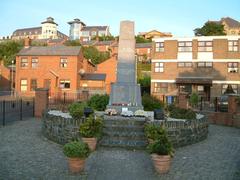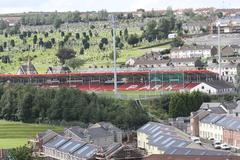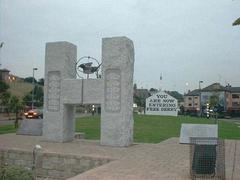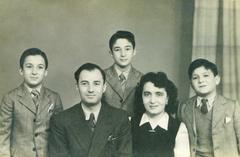Roman Catholic Diocese of Derry: Visiting Hours, Tickets & History Guide
Date: 14/06/2025
Introduction
The Roman Catholic Diocese of Derry is a cornerstone of spiritual, historical, and cultural life in northwest Ireland. From its early monastic origins to its current role serving a vibrant Catholic community, the diocese invites visitors to experience centuries of faith, resilience, and architectural achievement. Anchored by the majestic St Eugene’s Cathedral and the venerable Long Tower Church, Derry’s religious sites offer not only places of worship but also windows into Ireland’s tumultuous and inspiring past. This guide presents comprehensive information on visiting hours, ticketing, accessibility, and key sites—empowering you to make the most of your journey through Derry’s living heritage. (Derry Diocese History, Visit Derry, St Eugene’s Cathedral)
Table of Contents
- Early Christian Foundations and Monastic Origins
- Diocesan Formation and Medieval Development
- Reformation, Penal Times, and Catholic Resilience
- 19th Century Renewal and St Eugene’s Cathedral
- The Diocese Through the 20th Century
- Contemporary Structure and Community Role
- Visitor Information: Hours, Tickets & Tours
- Exploring Derry: Nearby Attractions & Travel Tips
- Frequently Asked Questions
- Conclusion & Further Resources
Early Christian Foundations and Monastic Origins
Derry’s origins as a sacred place predate Christianity, with its name (Daire, “oak grove”) recalling ancient Celtic rituals. In the sixth century, St. Columba (Colmcille) established a monastery here, shaping Derry into a major spiritual and intellectual center. The Teampall Mór (“Great Church”) became a beacon for learning, worship, and community life, attracting scholars from across Ireland. Until the 12th century, the area’s Christian organization was predominantly monastic, with abbots wielding significant influence (Catholic Encyclopedia, Derry Diocese History, Geographia).
Diocesan Formation and Medieval Development
The Synod of Kells (1152) formalized the diocesan structure, establishing Derry as a key ecclesiastical center. Initially based at Maghera, the bishop’s seat moved to Derry in the mid-13th century, with the Teampall Mór as cathedral. The diocese incorporated the historic sees of Pathlure and Ardstraw, both with roots in the region’s early Christian missionary activity. These boundaries have largely been retained to the present day, encompassing almost all of County Derry, parts of Tyrone and Donegal, and a small portion of Antrim (Derry Diocese History, Wikipedia).
Reformation, Penal Times, and Catholic Resilience
The 16th-century Reformation and subsequent Penal Laws posed grave challenges to Catholic practice in Ulster. While Protestant and Presbyterian communities grew among new settlers, the indigenous Catholic population remained steadfast. Derry’s Catholic clergy, including Bishop Redmond O’Gallagher (martyred in 1601), played a pivotal role in sustaining faith under persecution. Catholic worship persisted in secrecy, and the diocese endured long periods without resident bishops, administered instead by vicars until 1683 (Catholic Encyclopedia, Derry Diocese History, Academia.edu).
The construction of St Columba’s Long Tower Church in 1784, the first Catholic church built in Derry after the Reformation, symbolized the enduring strength and renewal of the Catholic community (Geographia).
19th Century Renewal and St Eugene’s Cathedral
The 19th century brought transformation and growth to the Diocese of Derry, particularly after Catholic Emancipation (1829). The crowning achievement was the construction of St Eugene’s Cathedral, begun in 1851 and completed in 1873. Designed by James Joseph McCarthy in Gothic Revival style, the cathedral stands today as the spiritual heart of the diocese. The era also saw the founding of educational institutions like St Columb’s College, strengthening the Church’s social and cultural influence (Visit Derry, Your Irish Adventure, Catholic Encyclopedia).
The Diocese Through the 20th Century
Throughout the 20th century, the Diocese of Derry played a vital role in the region’s social, political, and spiritual life. During the Troubles (1969–1999), the diocese’s clergy, notably Bishop Edward Daly, advocated for peace and provided pastoral care amid deep community divisions and violence. The Catholic Church continued to support education, social services, and interfaith dialogue, reaffirming its place at the center of community life (Derry Diocese History).
Contemporary Structure and Community Role
Today, the Diocese of Derry serves around 250,000 Catholics across 51 parishes spanning both Northern Ireland and the Republic of Ireland. St Eugene’s Cathedral remains the diocesan mother church, while other notable churches—such as the Long Tower, St Brigid’s, and the Church of the Immaculate Conception—continue to enrich the region’s cultural and spiritual landscape (GCatholic, Wanderlog).
The diocese is active in ecumenical and peace-building initiatives, as well as the organization of annual religious festivals, educational programs, and charitable outreach.
Visitor Information: Hours, Tickets & Tours
St Eugene’s Cathedral
- Location: Francis Street, Derry
- Visiting Hours: Monday to Saturday, 9:00 AM–5:00 PM; Sundays, 12:00 PM–4:00 PM (hours may vary for special events—check the official site for updates).
- Tickets: Free entry; donations welcome.
- Guided Tours: Available by request; advance booking recommended via the cathedral or diocesan office.
- Accessibility: Wheelchair accessible with assistance available.
- Audio Tours: Self-guided audio tours are offered (St Eugene’s Cathedral Audio Tour).
St. Columba’s Long Tower Church
- Location: Long Tower Street, Derry
- Visiting Hours: Monday to Saturday, 9:00 AM–5:00 PM; Sunday, during services.
- Tickets: Free entry.
- Accessibility: Wheelchair accessible with assistance.
Other Notable Churches
- Holy Family Church
- Our Lady of Lourdes
- St Brigid’s
- St Patrick’s
- Church of the Immaculate Conception
- St Oliver Plunkett’s
(Find a full list and more at Wanderlog)
Guidelines for Visitors
- Dress modestly and maintain respectful silence during services.
- Photography may be restricted during Mass; always ask for permission.
- Facilities such as restrooms and gift shops are available at major sites.
Exploring Derry: Nearby Attractions & Travel Tips
- Derry City Walls: Walk the 17th-century city walls for panoramic views and historical context.
- Peace Bridge: A symbol of reconciliation, linking the historic city center with the modern Waterside.
- Tower Museum: Delve into regional history, including the Siege of Derry and the Plantation of Ulster.
- Travel: Derry is accessible by car, rail, and bus. City of Derry Airport is 11 km away. UK pounds are the local currency; bring suitable adapters for UK plugs (LaidBackTrip).
Practical Tips
- Spring and summer (May–September) are ideal for visits and festivals.
- Book accommodations early for major feast days and cultural events.
- English is the main language; Irish (Gaelic) appears on some signage and in liturgy.
- Major churches offer accessibility features; inquire ahead for details.
Frequently Asked Questions
Q: What are St Eugene’s Cathedral visiting hours?
A: Monday–Saturday 9:00 AM–5:00 PM; Sundays 12:00 PM–4:00 PM. Check the official website for holiday variations.
Q: Is there an entry fee for the cathedral or Long Tower Church?
A: No, entry is free. Donations are appreciated.
Q: Are guided tours available?
A: Yes, at St Eugene’s Cathedral and some other sites. Audio tours are also available.
Q: Are the churches accessible to people with disabilities?
A: Yes, main sites are wheelchair accessible with assistance. Some historic churches may have limited access.
Q: May I photograph inside the churches?
A: Generally outside Mass times; always request permission during services.
Conclusion
The Roman Catholic Diocese of Derry is a living testament to Ireland’s spiritual endurance and cultural richness. With its historic churches, resilient community, and welcoming atmosphere, Derry invites visitors to connect deeply with faith, history, and heritage. Plan your visit by consulting up-to-date information on visiting hours and events, and enrich your journey with guided tours, interactive content, and local insights.
For more, download the Audiala app for guided audio tours, maps, and real-time updates. Stay engaged with the diocese’s evolving story by following official channels.
References and Further Reading
- Derry Diocese History
- Visit Derry: Churches & Cathedrals
- St Eugene’s Cathedral
- LaidBackTrip: Things to Do in Derry
- Catholic Encyclopedia: Diocese of Derry
- Wikipedia: Roman Catholic Diocese of Derry
- Geographia: Derry Heritage
- Wanderlog: Best Churches in Derry



